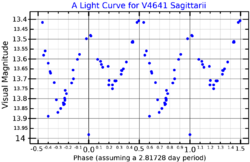Astronomy:V4641 Sagittarii
| Observation data Equinox J2000.0]] (ICRS) | |
|---|---|
| Constellation | Sagittarius |
| Right ascension | 18h 19m 21.63427s[2] |
| Declination | −25° 24′ 25.8493″[2] |
| Apparent magnitude (V) | 9.0 - 14.0[3] |
| Characteristics | |
| Spectral type | B9III[4] |
| Variable type | HMXB/BHXB/XN+ELL+E[3] |
| Astrometry | |
| Proper motion (μ) | RA: −0.734[2] mas/yr Dec.: +0.418[2] mas/yr |
| Parallax (π) | 0.1510 ± 0.0413[2] mas |
| Distance | 20,200 ± 2,300[4] ly |
| Orbit[4] | |
| Period (P) | 2.81730 d |
| Semi-major axis (a) | 17.5±1.0 R☉ |
| Inclination (i) | 72.3±4.1° |
| Periastron epoch (T) | 2,452,423.647 |
| Semi-amplitude (K2) (secondary) | 211.3±1.0 km/s |
| Details[4] | |
| Black hole | |
| Mass | 6.4±0.6 M☉ |
| Stellar companion | |
| Mass | 2.9±0.4 M☉ |
| Radius | 5.3±0.3 R☉ |
| Surface gravity (log g) | 3.5±0.1 cgs |
| Temperature | 10,250±300 K |
| Rotational velocity (v sin i) | 100.9±0.8 km/s |
| Other designations | |
| Database references | |
| SIMBAD | data |
V4641 Sagittarii is a variable X-ray binary star system in the constellation Sagittarius. It is the source of one of the fastest superluminal jets in the Milky Way galaxy.
In 1999 a violent X-ray outburst revealed it to contain a black hole.[6] At the time, it was considered to be the closest known black hole to Earth, at a distance of approximately 1,600 light-years (490 pc). Later observations showed it to be much farther away, reported in 2001 to be between 7.4 and 12.31 kpc,[7] 6.2 kpc in 2014,[4] and around 6.6 kpc according to its Gaia Data Release 2 parallax.[2]
The star in the binary system is a late B class giant with a mass about three times that of the Sun. It orbits a black hole about twice as massive every 2.8 days. The star is distorted, which causes variations in its brightness as it orbits and rotates. It is also slightly eclipsed by an accretion disc around the black hole. The system usually does not produce a significant amount of x-rays, but undergoes outbursts when the x-ray luminosity increases due to accretion onto the black hole driving superluminal jets.[7]
References
- ↑ Goranskij, V. P. (May 2001). "The Orbital V-band Light Curve of V4641 Sagittarii". Information Bulletin on Variable Stars 5068: 1. Bibcode: 2001IBVS.5068....1G. https://ui.adsabs.harvard.edu/abs/2001IBVS.5068....1G. Retrieved 13 March 2022.
- ↑ 2.0 2.1 2.2 2.3 2.4 2.5 Brown, A. G. A. (August 2018). "Gaia Data Release 2: Summary of the contents and survey properties". Astronomy & Astrophysics 616: A1. doi:10.1051/0004-6361/201833051. Bibcode: 2018A&A...616A...1G. Gaia DR2 record for this source at VizieR.
- ↑ 3.0 3.1 "V4641 Sgr". https://www.aavso.org/vsx/index.php?view=detail.top&oid=32341.
- ↑ 4.0 4.1 4.2 4.3 4.4 MacDonald, Rachel K. D. et al. (March 2014). "The Black Hole Binary V4641 Sagitarii: Activity in Quiescence and Improved Mass Determinations". The Astrophysical Journal 784 (1): 19. doi:10.1088/0004-637X/784/1/2. 2. Bibcode: 2014ApJ...784....2M.
- ↑ "V4641 Sgr". SIMBAD. Centre de données astronomiques de Strasbourg. http://simbad.u-strasbg.fr/simbad/sim-basic?Ident=V4641+Sgr.
- ↑ "Dramatic Outburst Reveals Nearest Black Hole". National Radio Astronomy Observatory. January 14, 2000. http://www.nrao.edu/pr/2000/v4641/.
- ↑ 7.0 7.1 Orosz, J. A. et al. (July 2001). "A Black Hole in the Superluminal Source SAX J1819.3-2525 (V4641 SGR)". The Astrophysical Journal 555 (1): 489–503. doi:10.1086/321442. Bibcode: 2001ApJ...555..489O. ""Finally, we find a distance in the range 7.40 ≤ d ≤ 12.31 kpc (90% confidence), which is at least a factor of ≈ 15 larger than the initially assumed distance of ≈ 1,600 light-years/500 pc."".
External links
Coordinates: ![]() 18h 19m 21.636s, −25° 24′ 25.6″
18h 19m 21.636s, −25° 24′ 25.6″
 |


